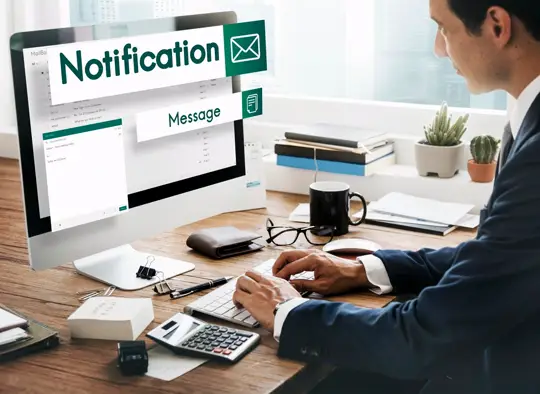How to Write a Job Application Email
Many students looking for jobs, especially fresh graduates, use email to send their resumes in addition to using job platforms like Aniday. This is especially true when applying to overseas companies. However, many resumes are often discarded before HR even opens them.
In this blog post, we will address the four common mistakes that people make when sending a job application email, hopefully at the end of this blog post, you will be able to avoid them.
1. Choosing the Right Email Service for Job Hunting

Some people suggest that for job seekers, it’s best to use universally recognized email services like Gmail or Outlook. If your school provides email services, using a school domain email can be a good choice as it emphasizes your academic background. However, these are not hard and fast rules.
It’s important to note that there is no one-size-fits-all email service for job applications. The key is to choose an email service that is reliable and widely used in your target job market. For instance, while certain email services may be popular and reliable in one country, they may not be as effective in another due to different internet regulations and practices.
Many job seekers have found that their job applications become ineffective if they use an email service that is not commonly used or recognized in the country where the job is located. Therefore, choosing an email service that can guarantee delivery and is familiar to employers in your target job market is crucial for successful job hunting.
2. Email Signature and Subject
What truly matters is the content of the email, not the email service you use. Ensuring that your emails are sent and received accurately and on time is the most important aspect. Please turn off email signatures like "Sent from my device" because they can make your email look less formal. While an email signature is not necessary, if you choose to include one, use a horizontal line to separate it and include basic information like your name, school, job title, contact information, and mailing address to facilitate further contact.
Usually, when HR receives dozens of emails with the subject line "Job Application," or similar variants, it can be a bit depressing.
Moreover, HR often receives emails from senders with bizarre pseudonyms or nonsensical usernames. In most cases, these emails are never opened. Therefore, change your email name to your real name.
If the job posting specifies a submission format (e.g., Name-School-Major-Position Applied For), even if you feel that this format doesn't suit your characteristics, follow it. Failure to do so can lead to your email being ignored. When a format is given, it is for a reason. Don't add extra burden to the recipient; be helpful and kind as this is one of the most basic criteria many large companies' HR departments use to evaluate candidates.
3. Email Body

Remember, don't just send your resume without any content in the email body. If your email has no text in the body, the chances of it being ignored increase slightly. In the email body, you can briefly introduce yourself and highlight your strengths while specifying the position you are applying for. If you are applying to a foreign company, you may consider including a short cover letter, but keep it concise. If your email has no introduction or greeting, it can create the impression that your interest in the job is weak.
Moreover, there is no need to copy and paste the entire resume into the email body. Apart from potentially making the format look messy, repeating the information in the resume doesn't benefit the recipient. Since you've attached your resume, let the recipient read it properly.
4. Attachments
First, avoid attaching too many files. If there are no required documents other than your resume and cover letter, stick with those. Sending your graduation certificates and awards unless explicitly asked can add to HR's workload.
Use PDFs whenever possible. Avoid using DOC files and certainly don't use PPT, RTF, or PAGES formats. Sometimes Word documents from Windows can appear as garbled text on Mac, especially when the fonts don't match. So, export your documents as PDFs to ensure that the recipient sees the format you intended.
Naming attachments is also important. You can follow the naming conventions in the subject line for your resume. If the recipient specifies a naming format, be sure to follow it. Put yourself in the recipient's shoes. They might receive dozens or hundreds of resumes, and using a uniform naming format makes their job easier.
Finally, remember to include your name and contact information on your resume. If your resume doesn't have your name on it, HR won't know where to start. Most HR professionals don't have time to go through emails one by one searching for the candidates' names.
In Summary
Sending a job application email may seem straightforward, but avoiding common mistakes can significantly increase your chances of standing out to potential employers. Choosing the right email service, crafting a professional email signature and subject, paying attention to the email body, and handling attachments with care are all key aspects of a successful application. By following these guidelines, you can ensure that your job application email is not only noticed but also positively remembered by HR professionals.
Aniday wishes you all the best as you venture out to fin you dream job. If you need any help with finding a job, please don’t hesitate to contact us immediately!
Aniday's HR Services
Headhunting Service
Find and recruit quality candidates in just 1 week! Supported by 40,000 experienced headhunters in IT, Finance, Marketing… capable of recruiting in any region.
Headhunting Service ➔Employer of Record (EOR) Service
On behalf of your business, we recruit employees and handle payroll without the need to establish a company in markets such as Vietnam, Singapore, Malaysia, India, Indonesia…
Employer of Record (EOR) Service ➔